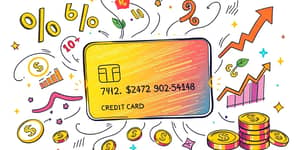Credit cards remain one of the most influential financial tools available today, offering convenience, rewards, and the opportunity to build credit. Yet, they carry inherent risks when not managed with intention and care. Learning to wield plastic responsibly can transform credit cards from potential pitfalls into powerful allies on your path to financial stability.
In 2025, Americans carry nearly $1.18 trillion in credit card debt and hold an average of 3.9 cards each. These figures reflect both the utility and the challenges of revolving credit in an era of rising living costs and digital payment innovation.
The Credit Card Landscape in 2025
The credit card ecosystem has evolved dramatically over recent decades. In Q1 2025, purchase volume topped $5.82 trillion and is expected to exceed $6 trillion by 2026. Meanwhile, digital wallets account for nearly half of global transactions, reshaping how consumers engage with plastic.
Understanding the current environment can help you navigate credit wisely and avoid common traps.
The Dangers of Revolving Debt
Carrying a balance from month to month can swiftly escalate costs through compounding interest. With average APRs approaching 30%, even a small balance can become a significant burden over time.
More than half of cardholders maintain balances for a year or longer, and 48% juggle month-to-month debt. This pattern often stems from unexpected expenses and high inflation, but interest charges can eclipse initial purchase amounts, creating a cycle of increasing liability.
Keys to Responsible Credit Card Use
Adopting disciplined habits can prevent debt accumulation and strengthen financial health.
- Pay in full each month to avoid interest charges entirely.
- Keep utilization below 20% to 30% of your total credit limit.
- Make payments on time to protect and build your credit score.
- Review statements for errors or fraud as soon as they arrive.
- Limit new credit card applications to reduce overspending temptation.
These simple strategies can yield substantial long-term benefits, including lower costs, higher credit scores, and greater peace of mind.
Credit Utilization and Your Score
Credit utilization—the percentage of available credit you’re using—is one of the most influential factors in credit scoring models. Keeping your utilization under 30% signals responsible borrowing behavior, while consistently staying below 20% can turbocharge score improvements.
High utilization suggests financial overextension and can trigger score drops even if payments are on time. Monitoring balances and adjusting spending before statement dates helps ensure you never unintentionally cross critical thresholds.
Generational Payment Preferences
Consumer behavior varies across age groups. In 2025, baby boomers lead credit card adoption at 83%, while Gen Z lags at 68%. Yet, all demographics show a strong preference for debit cards, with millennials topping the list at 74%. Digital wallets, now responsible for nearly half of global transactions, are reshaping how each generation approaches credit.
Awareness of these trends can help financial educators and issuers tailor literacy programs and rewards to the habits of each cohort, ultimately fostering more informed credit management across the board.
Safeguarding Against Fraud and Identity Theft
Projected US credit card fraud losses reach $12.5 billion in 2025, a 46% increase year-over-year. Ecommerce-specific fraud has surged 140% in three years, underscoring the importance of proactive security measures.
Staying vigilant can protect your finances and reputation. Enable transaction alerts, use strong unique passwords for digital wallets, and consider virtual card numbers for online shopping. If you detect unauthorized activity, report it immediately to freeze your account and minimize losses.
Building Long-Term Financial Resilience
Credit cards offer benefits, but they should never replace a robust emergency fund. Unexpected events—medical bills, car repairs, or sudden job loss—can force reliance on plastic if savings are insufficient.
- Automate contributions to a dedicated savings account each paycheck.
- Build a robust emergency savings fund covering three to six months of expenses.
- Use credit rewards for cash-back or travel rather than new purchases.
Over time, disciplined saving habits reduce the likelihood of high-interest borrowing and foster greater financial independence.
Credit cards can be both a powerful ally and a formidable foe. By embracing disciplined payment practices, monitoring utilization, and staying vigilant against fraud, you lay the groundwork for a secure financial future. Responsible credit card use is not a one-time achievement—it’s a lifelong commitment to thoughtful decision-making and proactive management.
Whether you’re a first-time cardholder or a seasoned spender, adopt these principles to transform your relationship with credit. With intention and awareness, you can harness the benefits of plastic while safeguarding your financial health for years to come.
References
- https://www.youtube.com/watch?v=yrksgzdrjQE
- https://tradingeconomics.com/united-states/debt-balance-credit-cards
- https://merchantcostconsulting.com/lower-credit-card-processing-fees/credit-card-fraud-statistics/
- https://www.lendingtree.com/credit-cards/study/credit-card-debt-statistics/
- https://www.cardrates.com/news/credit-card-usage-statistics/
- https://www.bankrate.com/credit-cards/news/credit-card-debt-report/
- https://use.expensify.com/blog/credit-card-statistics
- https://www.newyorkfed.org/microeconomics/hhdc










